Interview: Exploring Zoetrope Picture Discs with Designer Drew Tetz
By Simon Daley
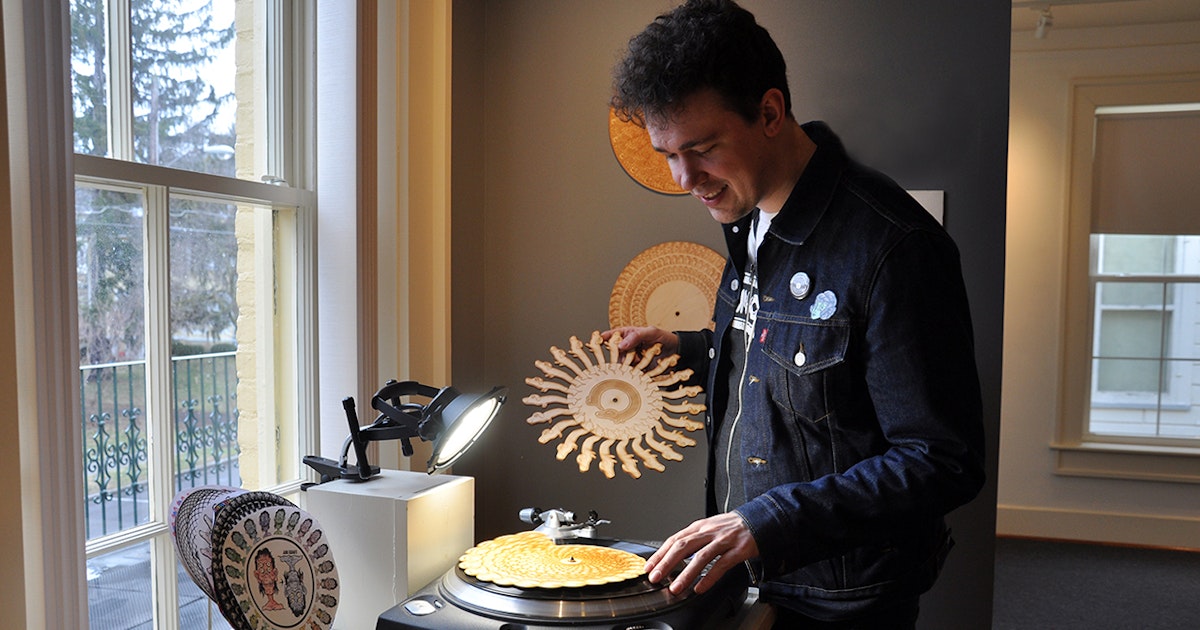
We spoke with graphic designer Drew Tetz to learn what goes into making a zoetrope picture disc, his introduction to the technique and where to start when creating your own.
If you’ve visited a record store in recent years or opened one of your social feeds, then you’ve probably seen them. Static or in motion, Zoetrope picture discs are a feast for the eyes. Seemingly repeating concentric circles in the record artwork hint at the fun to be had, and when played on a turntable and viewed through a modern camera phone the animated design comes to life.
When researching the people behind these pieces of art, one name comes up time and time again – Drew Tetz (Tate-ZUH). Hailing from Maryland and now based in Georgia, Tetz has carved out a niche in the vinyl industry and has been busy working with artists and labels like Grateful Dead, Disney, Dua Lipa and Olivia Rodrigo. Strolling the floor at Precision Record Pressing on any given month and you’re likely to see some of his work on press, as Zoetrope picture discs have soared in popularity in recent times. After a year of trying, we finally sat down with the man himself to learn what a Zoetrope actually is, how he was introduced to the technique and most importantly – what projects of his are about to hit stores.
Q: You’ve created dozens of zoetrope designs over the past couple of years, many of which have been pressed at PRP. We’re often explaining to team members what a zoetrope is… I wonder how you would explain it to the uninitiated?
A: Zoetropes are a form of animation which use a rotating disc synchronized with a flickering light to create the illusion of motion. Modern incarnations achieve this with turntables & camera phones, but the original version was fully analog & even predates the flipbook! I think the easiest way to think of it is as a sequence of images arranged around a circle, like a film strip — many turntables have “strobe dots” to help listeners visually perceive the speed that their records are rotating at, & this is sort of like that concept pushed to the next level. The number of frames on the record coincides with the speed of the turntable, so that when the spinning disc is viewed through a 30FPS camera or under a 30Hz strobe light (both of which break real time into 30 discrete slices,) it’s rotating at exactly the right rate that the images appear to be a single consistent whole.
How were you first introduced to the idea of using a vinyl picture disc as the canvas for a zoetrope?
While there have been many artists over the years to mix records with zoetropes (& the art historians in the crowd would rebuff me for not mentioning Red Raven Records, Reuben Sutherland, Jim Le Fevre, & John Edmark,) the person whom I first saw pioneering the field & my personal OG in the scene would have to be Kev Foakes, AKA DJ Food. In addition to his own healthy audio/visual artistic process, Kev worked on the art behind many pivotal 00s Ninja Tune releases, & his “Cirrus” zoetrope for Bonobo is probably one of the most notable modern vinyl zoetrope releases.
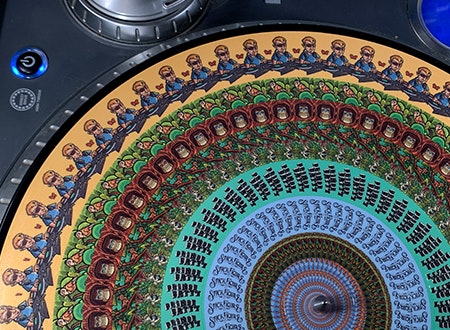
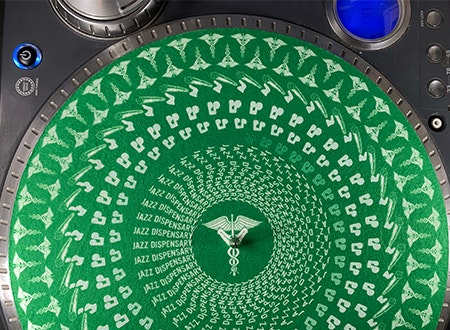
Where does your process begin with creating a zoetrope, are you looking for a specific type of design asset to build upon?
Since the visual identity of the album is generally established before I join the project, I usually have the luxury of lots of solid assets to work from & a standard to follow. This is awesome for me, because it really helps me understand the artist’s vision & the album’s world — I really want to emphasize those visual cues that fans will associate with the music & make it an extension of the whole project. For that reason, I’m always stoked when I can look at the whole package — cover art, music videos, type treatment, whatever. Even if not every single piece makes it into the animation, it definitely helps in comprehending the album’s identity. Having said all that: the most fun kind of material to work from has to be when I get layered original files from an illustrator! Feels so cool getting to look at their art up close & help it move around.
You’ve worked on picture disc designs for some of the biggest artists on the planet… from John Lennon to Gorillaz, Dua Lipa and Olivia Rodrigo. Which three projects have been major milestones for you since you began working on album art?
Yeah, it’s been a trip! Honestly it’s all way beyond anything that I’d ever dreamed, but I’m so grateful to be able to artistically dialogue with music that I love.
It’s tough to limit to three, but just to keep myself within the past year, I’d say Disney’s Tim Burton’s The Nightmare Before Christmas, John Lennon’s Mind Games, and Weezer’s Weezer (Blue Album).
Disney is as close to heaven as it gets for an animation nerd like me, & I’ve watched NMBC literally hundreds of times since I was a kid, so it was a real treat getting to loop Jack’s stop motion antics. On top of that, their team are just the sweetest folks, lovely to work with!
John Lennon is of course one of the greatest songwriters of all time, but the Mind Games project was made extra special by the level of care that Sean Ono Lennon (& the wonderful Lennono team) took in elevating the deluxe edition into essentially a self-contained museum exhibit. Truly an honor to work with creatives who tell you point blank “Hey man, I just wanna make this as cool as possible, what fun stuff can we do?”
Finally, Weezer’s Blue Album is my personal all time favorite album, & was literally the only thing in my car’s CD player for about a decade. I don’t think I can properly express what it means to me, but it’s going to stick with me forever.
Where would you advise someone to begin if they want to create their own zoetrope design? Are there any books or online guides suitable for beginners?
It’s admittedly a pretty weird niche to get into, & there is unfortunately very little documentation about the process, but the Coven of the Rotating Image is actually a pretty friendly bunch & we’re always grateful to welcome new sorcerers into the fold! I think the only online guide is this basic pattern-based tutorial I wrote for MakeZine in 2016. It’s one of the more simplified techniques, but it’s a decent entry point to thinking about polar grids & image sequences. If your library lets you access scholarly articles, you can also look up my MFA thesis “Zoetrope Blues”! It doesn’t feature a guide, I’m afraid, but does go more into the history.
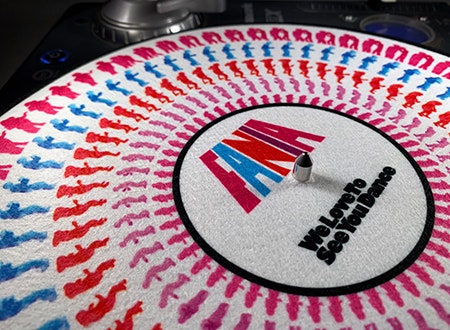
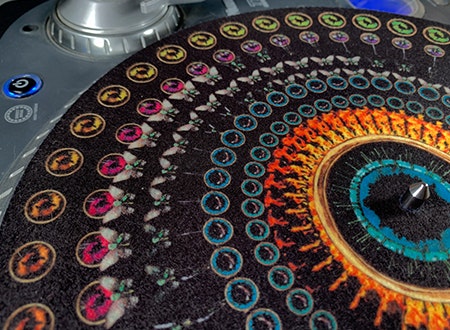
Earlier this year you ventured into the world of jewelry design, collaborating with Peaceimages Jewelry on a pair of Run The Jewels earrings. Tell us about that project and how it came about?
Yeah, that was a fun one! The connection came from DJ Trackstar, Run the Jewels’ DJ, after seeing some of my 3D zoetrope work; his wife Camille is the brains behind Peaceimages Jewelry, & I helped her out with the CAD side of her Hot Comb earrings. She came up with the RTJ earring design for a collab collection with the band, & I was stoked to help a little with getting her vision ready for machining.
What can we expect from you in 2025… are there any upcoming projects that you can tell us about?
Already have some projects lined up for 2025 that I’m super excited about!! I don’t know how many of them I’m allowed to talk about so I’ll remain vague & mysterious. Lots of cool albums celebrating anniversaries in 2025 so you can definitely expect some fun represses! Suffice to say I’m grateful to be working with so many creative artists & labels passionate about making cool weird art stuff.
For more information about Drew Tetz and his Zoetrope work visit drewtetz.com.
Header photo by Drew Tetz